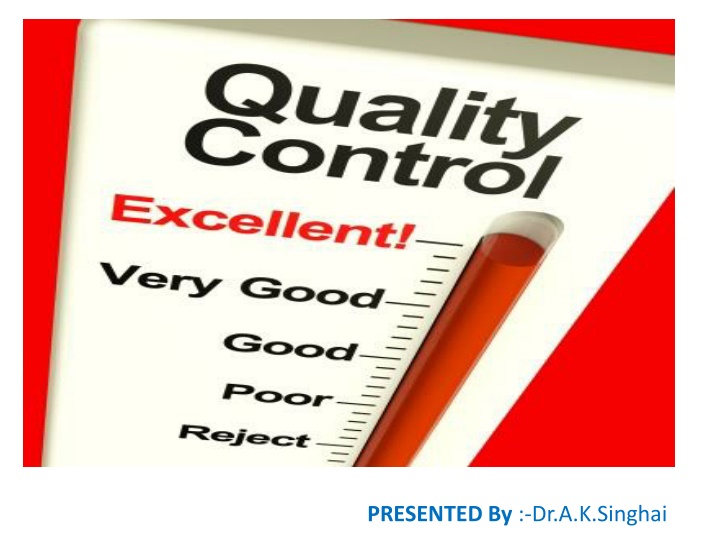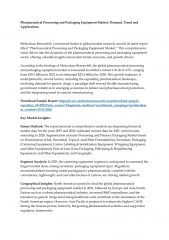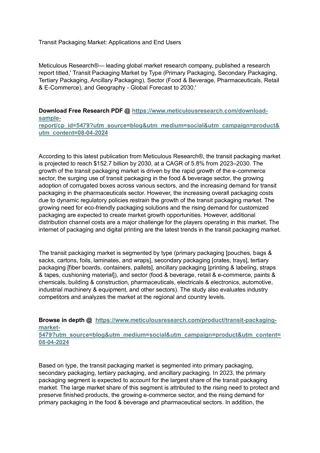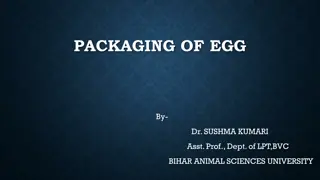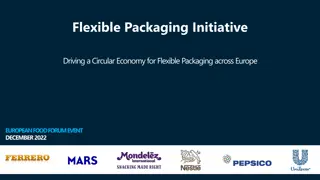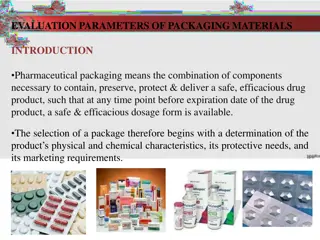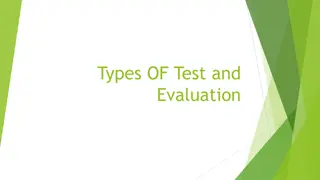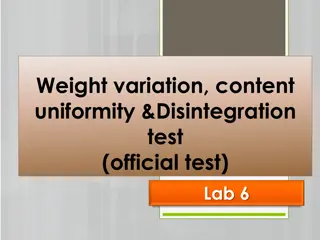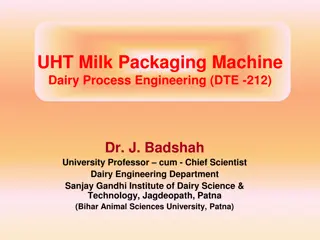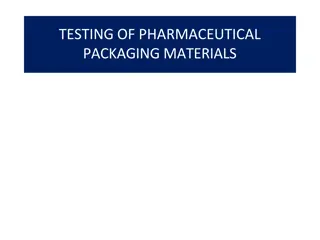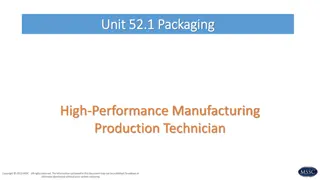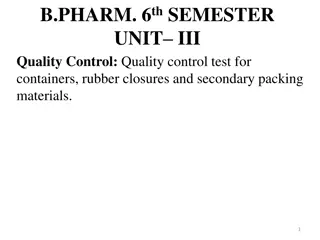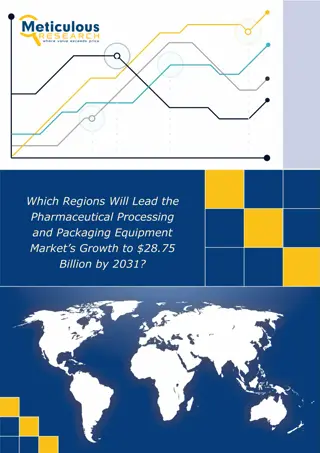Overview of Pharmaceutical Packaging: Basic Terminologies, Quality Control Tests, and Container Types
Pharmaceutical packaging plays a crucial role in maintaining the effectiveness and safety of medications. This content delves into basic terminologies, quality control tests for containers, closures, and secondary packaging, as well as an introduction to general packaging practices. It also covers the composition of packaging materials like glass containers, plastics, and metals. Additionally, it discusses the qualities of a good container, types of containers such as well-closed, single dose, and multi-dose containers, and their respective uses in the pharmaceutical industry.
Download Presentation

Please find below an Image/Link to download the presentation.
The content on the website is provided AS IS for your information and personal use only. It may not be sold, licensed, or shared on other websites without obtaining consent from the author.If you encounter any issues during the download, it is possible that the publisher has removed the file from their server.
You are allowed to download the files provided on this website for personal or commercial use, subject to the condition that they are used lawfully. All files are the property of their respective owners.
The content on the website is provided AS IS for your information and personal use only. It may not be sold, licensed, or shared on other websites without obtaining consent from the author.
E N D
Presentation Transcript
QUALITY CONTROL TESTS FOR CONTAINERS, CLOSURES & SECONDARY PACKaGING
GENERAL PACKAGING......... INTRODUCTION Packaging is the process by which the pharmaceuticals are suitably placed so that they should retain their therapeutic effectiveness from the time of their packaging till they are consumed. Definition: Packing is the art and science which involves preparing the articles for transport, storage, display and use. Pharmaceutical packaging is the means of providing protection, presentation, identification, information and convenience to encourage compliance with a course of therapy. PACKAGING MATERIALS PACKAGING MATERIALS GLASS CONTAINERS PLASTICS DRUG PLASTIC CONSIDERATIONS METALS CLOSURES CLOSURE LINERS RUBBERS Composition of package: (a) Container (b) Closure (c) Carton or Outer (d) Box
CONTAINER: A container for a Pharmacopoeial article is intended to contain a drug substance or drug product with which it is, or may be in direct contact. The closure is a part of the container. QUALITIES OF GOOD CONTAINER: The container must be neutral towards the material which is stored in it. The container must not interact physically or chemically with the substance which it holds. It should help in maintaining the stability of product against the environmental factors which causes its deterioration. It should be made of materials which can withstand wear and tear during normal handling. It should be made of materials which can withstand wear and tear during normal handling. It should be able to withstand changes in pressure and temperature. The materials used for making of the container must be non-toxic.
TYPES OF CONTAINERS: Containers are divided into following types on the basis of their utility: 1. Well closed containers: A well-closed container protects the contents from loss during transportation, handling, storage or sale. 2. Single dose containers : These containers are used to supply only one of medicament and hold generally parenteral products. E.g. ampoules and vials 3. Multi dose containers: These containers allow the withdrawal of dose at various intervals without changing the strength, quality or purity of remaining portion. These containers hold more than one dose and are used for injectables. E.g. Vials
Contd....... 4. Air-tight containers: These are also called hermetic containers. These containers have air-tight sealing or closing. These containers protect the products from dust, moisture and air. Where as air-tight sealed containers are used for injectables, air-tight closed containers are meant for the storage of other products. 5. Aerosol containers: These containers are used to hold aerosol products. These containers have adequate mechanical strength in order to bear the pressure of aerosol packing. 6. Light-resistant containers: These containers protect the medicament from harmful effects of light. These containers are used to store those medicaments which are photo-sensitive.
CLOSURES: A closure is the part of the package which prevent the contents from escaping and allow no substance to enter the container. Closures are available in five basic designs: 1. Screw on, threaded or lug 2. Crimp on(crowns) 3. Press on(snap) 4. Roll on and 5. Friction CLOSURE TYPES : 1. Threaded screw cap: When a screw cap is applied, its threads engaged with the corresponding threads molded on the neck of the bottle. A liner in the cap, pressed against the opening of the container, seals the product in the container and provide the resistance to chemical and physical reaction with the product. The screw cap is commonly made of metal or plastics. The metal is usually tin plate or aluminum and in plastic is thermoplastic and thermosetting material.
2. Lug cap: The lug cap is similar to the threaded screw cap and operates on the same principle. It is simply an interrupted thread on the glass finish, instead of a continuous thread. Unlike the threaded closure, it requires only a quarter turn. The lug cap is used for both normal atmosphere pressure and vacuum pressure closing. 3. Crown caps: - This style cap is commonly used as a crimped closure for beverage bottles. 4. Roll-on Closures : The aluminum roll on cap can be seal securely, opened easily and resealed effectively. Resealable, non resalable and pilfer proof types of roll on closures are available for use on glass or plastic bottles.
5. Pilfer proof closures : It is similar to roll on closure but has a greater skirt length. This additional length extends below the threaded portion and fastened to the basic cap by the series of narrow bridges. When the closure is removed the extra portion remains in the space on neck of the container, this indicates that the package has been opened. 6. Closure liners: A liner may be defined as any material that inserted in a cap to effect a seal between the closure and the container. It is of two types: 1. Homogeneous liner These are one piece liners available as disk or a ring of rubber or plastic. It can be withstand high temperature sterilization. 2. Heterogeneous liners These are composed of layers of different materials chosen for specific requirements. It consists of facing and backing. Facing is in contact with product and backing provides questioning effect.
RUBBERS (Elastomers): Excellent material for forming seals, used to form closures such as bungs for vials or in similar applications such as gaskets in aerosol cans. Categories of Rubbers: 1) Natural rubbers: Suitable for multiple use closures for injectable products as rubber reseals after multiple insertion of needle. Disadvantages are; i. It doesn't well tolerate multiple autoclaving becoming brittle and leads to relative degree of extractable material in presence of additives. i. Risk of product absorbing on or in to a rubber. ii. It has certain degree of moisture & gas permeation. 2) Synthetic rubber: Have fewer additives and thus fewer extractable and tends to experience less sorption of product ingredients. Are less suitable for repeated insertions of needle because they tend to fragment or core pushing small particles of the rubber in to the product. E.g. Silicone, butyl, bromobutyl, chlorobutyl etc. Silicone is least reactive but it does experience permeability to moisture and gas. Softer rubbers experience less coring and reseal better, harder Rubbers are easier to process on high speed packaging lines.
QUALITY CONTROL TESTS FOR GLASSES 1) CHEMICAL RESISTANT OF GLASS CONTAINERS A) POWDERED GLASS TEST: It is done to estimate the amount of alkali leached from the powdered glass which usually happens at the elevated temperatures. When the glass is powdered, leaching of alkali is enhanced, which can be titrated with 0.02N sulphuric acid using methyl red as an indicator. Step-1: Preparation of glass specimen: Few containers are rinsed thoroughly with purified water and dried with stream of clean air. Grind the containers in a mortar to a fine powder and pass through sieve no.20 and 50. Step-2: Washing the specimen: 10gm of the above specimen is taken into 250 ml conical flask and wash it with 30 ml acetone. Repeat the washing, decant the acetone and dried after which it is used within 48hr. Procedure: 10gm sample is added with 50ml of high purity water in a 250ml flask. Place it in an autoclave at 121 C 2 C for 30min.Cool it under running water. Decant the solution into another flask, wash again with 15ml high purity water and again decant. Titrate immediately with 0.02N sulphuric acid using methyl red as an indicator and record the volume.
B) WATER ATTACK TEST:This is only for treated soda lime glass containers under the controlled humidity conditions which neutralize the surface alkali and glass will become chemically more resistant. Principle involved is whether the alkali leached or not from the surface of the container. Procedure: Rinse thoroughly with high purity water. Fill each container to 90%of its overflow capacity with water and is autoclaved at 121 C for 30min then it is cooled and the liquid is decanted which is titrated with 0.02N sulphuric acid using methyl red as an indicator. The volume of sulfuric acid consumed is the measure of the amount of alkaline oxides present in the glass containers. TESTS CONTAINER VOL.OF 0.02N H2SO4 Powdered glass test Type I Type II Type III 1.0 8.5 15.0 Water attack test Type II 0.07 0.02 Type II(100ml or below) Type II(above 100ml)
2) HYDROLYTIC RESISTANCE OF GLASS CONTAINERS: Rinse each container at least 3 times with CO2 free water and fill with the same to their filling volume. Also fill & Cover the vials and bottles and keep in autoclave. Heat to 100 C for 10min and allow the steam to issue from the vent cork. Rise the temp from 100 C to 121 C over 20min. Maintain the temp at 121 C to 122 C for 60min.Lower the temp from 121 C to 100C over 40min venting to prevent vacuum. Remove the container from autoclave, cool and combine the liquids being examined. Measure the volume of test solution into a conical flask and titrate with 0.01M HCl using methyl red as an indicator. Perform blank with water and the difference between the titration represents the volume of HCl consumed by the test solution. Nominal capacity of container (ml) Number of containers to be used Volume of test solution to be used for titration (ml) 5 or less at least 10 50.0 6 to 30 at least 5 50.0 More than 30 at least 3 100.0
3) ARSENIC TEST: This test is for glass containers intended for aqueous parenterals. Wash the inner and outer surface of container with fresh distilled water for 5min.Prep test as described in the test for hydrolytic resistance for an adequate no. of samples to produce 50ml.pipette out 10ml solution from combined contents of all ampoules to the flask. Add 10ml of HNO3 to dryness on the water bath, dry the residue in an oven at 130 C for 30min cool and add 10ml hydrogen molybdate reagent .Swirl to dissolve and heat under water bath and reflux for 25min. Cool to room temp and determine the absorbance at 840nm.Do the blank with 10ml hydrogen molybdate. The absorbance of the test solution should not exceed the absorbance obtained by repeating the determination using 0.1ml of arsenic standard solution (10ppm) in place of test soln. 4) THERMAL SHOCK TEST: Place the samples in upright position in a tray. Immerse the tray into a hot water for a given time and transfers to cold water bath, temp of both are closely controlled. Examine cracks or breaks before and after the test. The amount of thermal shock a bottle can withstand depends on its size, design and glass distribution. Small bottles withstand a temp differential of 60 to 80 C and 1 pint bottle 30 to 40 C. A typical test uses 45C temp difference between hot and cold water.
5) INTERNAL BURSTING PRESSURE TEST: The most common instrument used is American glass research increment pressure tester. The test bottle is filled with water and placed inside the test chamber. A scaling head is applied and the internal pressure automatically raised by a series of increments each of which is held for a set of time. The bottle can be checked to a preselected pressure level and the test continues until the container finally bursts. 6) LEAKAGE TEST: Drug filled container is placed in a container filled with coloured solution (due to the addition of dye)which is at high pressure compared to the pressure inside the glass container so that the coloured solution enters the container if any cracks or any breakage is present. 7) ANNEALING TEST: The sample is examined by polarized light in either a polariscope or strain viewer. The strain pattern is compared against standard discs or limit samples. 8) VERTICAL LOAD TEST: The bottle is placed between a fixed platform & a hydraulic ramp platform which is gradually raised so that a vertical load is applied. The load is registered on pressure gauge. 9) AUTOCLAVING (121 C for 60 min) Ability of a filled or empty container to withstand autoclaving may be checked.
QUALITY CONTROL TESTS FOR PLASTICS: 1) LEAKAGE TEST: Fill 10 containers with water, fit with intended closures and keep them inverted at room temperature for 24hr.The test is said to be passed if there is no signs of leakage from any container. Leakage test for plastic containers (non-injectables & injectables 1996 IP): Fill 10 plastic containers with water and fit the closure Keep them inverted at room temperature for 24 hrs No sign of leakage should be there from any container. 2) COLLAPSIBILITY TEST: This test is applicable to the containers which are to be squeezed for removing the contents. A container by collapsing inward during use, yield at least 90% of its normal contents at the required rate of flow at ambient temperature.
3) WATER PERMEABILITY TEST FOR PLASTIC CONTAINERS (INJECTABLE PREPARATIONS IP 2014): 4) CLARITY OF AQUEOUS EXTRACT: Select unlabelled, unmarked and non laminated portions from suitable containers, taken at random. Cut these portions into strips, none of which has a total surface area of 20sq.cm.Wash the strips free from extraneous matter by shaking them with at least two separate portions of distilled water for about 30sec. In each case and drain off the water thoroughly. Thus processed sample is taken in to the flask, previously cleaned with chromic acid mixtures and rinsed with several portions of distilled water and added 250ml dist water. Cover the flask and autoclave at 121 C for 30min.Carry out the blank determination using 250ml dist water. Cool and examine the extract, it should be colourless and free from turbidity.
5) TRANSPARENCY TEST: Standard suspension preparation: 1gm hydrazine sulphate in 100ml water and set aside for 6hr. Take 25ml of this solution and add 25ml of 10%w/v hexamine and stand for 24hr. Test solution preparation: Sample is prepared by 16fold dilution of the standard suspension. Fill 5 containers cloudiness detectable when compared to water filled containers. Absorbance is measured at 640nm and the range is within 0.37 and 0.43. 6) BIOLOGICAL TESTS: A) Systemic Injection Test: (Test animal Albino Mice) Inject each of 5 mice in test group with sample or blank observe the animals immediately, again after 4hr & then at 24, 48, 72hrs. If none of animals shows significant greater biological reactivity than the blank the sample meets the requirements. Limit- If abnormal behavior such as Convulsion or Prostration occurs or if body weight loss is greater than 2g, the sample does not meet the requirements. B) Intra Cutaneous Test: (Test animal- Rabbit) Examine the sites of for any tissue reaction like erythema, oedema, neuosis at 24, 48, 72 hours after injection. Limit- difference between the scores of sample and blank should be lesser than 1.0. C) Eye Irritation Test On Rabbits: (Test animal - albino rabbits) Limit- Sample extract shows no significant irritant response during the observation period with blank extract.
QUALITY CONTROL OF CLOSURES PREPARATION OF SAMPLE(SOL.-A): Wash closures in 0.2%w/v of anionic surface active agents for 5min.Rinse 5 times with dist. water and add 200ml water and is subjected to autoclave at 119 to 123 C for 20 to 30min covering with aluminum foil. Cool and separate solution from closure (soln-A). 1) STERILITY TEST: When treated closures are subjected to sterilization test at 64-66 C and a pressure of about 0.7 kPa for 24hr. 2) RESIDUE ON EVAPORATION: 50ml of solution A is evaporated to dryness at 105 C.Then weigh the residue NMT 4mg. 3) PENETRABILITY: This is measured to check the force required to make a hypodermic needle penetrate easily through the closure. It is measured by using the piercing machine. The piercing force must not exceed a stated value. If it exceeds that stated value, the hypodermic needle can be damaged as a result of undesirable hardness of the closures.
5) SELF SEALABILITY: This test is applicable to closures intended to be used with water.
6) pH OF AQUEOUS EXTRACT: 20ml of solution A is added with 0.1ml bromothymol blue when it is added with a small amount of 0.01M NaOH which changes the colour from blue to yellow. The volume of NaOH required is NMT 0.3ml and if it is done with HCl, the volume of HCl needed should NMT 0.8ml. 7) LIGHT ABSORPTION TEST: It must be done within 4hrs of preparing solution A. It is filtered through 0.5 filter and its absorbance is measured at 220 to 360nm. Blank is done without closures and absorbance is NMT 2.0. 8) REDUCING SUBSTANCES: 20ml of solution A is added with 1ml of 1M H2SO4 and 20ml of 0.002M KMnO4 and boil for 3 min then cool and add 1gm of potassium iodide which is titrated with sodium thio-sulphate using starch as an indicator. Blank is done and the difference between titration volumes is NMT 0.7ml.
QUALITY CONTROL OF METALLIC TINS 1) DESCRIPTION: Metallic tins having smooth inner surface. The upper surface is sealed consists a clip to break the seal. The lower surface is open. 2) DIMENSIONS: Height- Measure the height in mm of 10 metallic tin, individually from the lower surface edge to the upper rim. Limit- Specimen metallic tins with tolerance-170mm 10mm. 3) DIAMETER: Inner diameter- Measure the inner diameter of 10 metallic tins. Limit- NLT 98mm. Outer diameter: Limit-NMT 105mm. 4) CLEANLINESS CHECK: It should not be dirty, damaged, stained or consist of any foreign particles.
Quality Assurance Aspects Of Packaging To ensure that patients and consumers receive high-quality drugs, the quality management system must take the following considerations into account if the required quality of packaging is to be obtained: the requirements of the national authorities and the relevant legislation the product the production process the manufacturers internal policies (safety, marketing, etc.). Bad packaging which is the result of deficiencies in the quality assurance system for packaging can have serious consequences, and packaging defects can create problems that may result in drug recalls. Such defects may include breakage, and problems relating to printing or inks, or errors on labels and package inserts (patient information leaflets). The use of GMP and quality control will prevent the release of a defective medicinal product. Packaging processes and equipment need validation/qualification in the same way as any other part of processing within a pharmaceutical facility.
Testing programme Quality control tests are intended to check the identity of the material concerned. Complete pharmacopoeial or analogous testing may also be carried out, as may special tests, where necessary. All written specifications for packaging materials and containers should include the nature, extent and frequency of routine tests. Routine tests vary according to the type of material and its immediate packaging, the use of the product, and the route of administration. Nevertheless, such tests usually include the following: visual inspection (cleanliness, defects) tests to identify the material dimensional tests physical tests chemical tests microbiological tests THE FOLLOWING PHYSICAL TESTS ARE PERFORMED (ACCORDANCE TO LATEST USP) Multiple internal reflectance s(to ensure that the material of the container falls within the range of HDPE or LDPE as specified in the test), Thermal analysis (to check compliance to pre defined endotherms and exotherms temperatures), Light transmission (to check protection from light), Water vapor permeation (to check protection from moisture permeation) Heavy metals, Nonvolatile residue.
